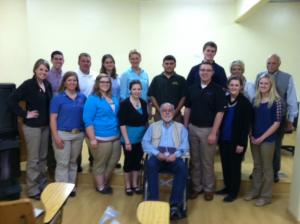By: Mollie Lastovica, Texas A&M University and Sam Tauchen, University of Wisconson – River Falls
Today we began our trek to Juiz de Fora bright and early, but only after doing what we have learned to do best–eating. Our hotel in Petropolis had a plethora of breads, pastries, fruits, cheeses, and ham for us to indulge on. The drive to Juiz de Fora was about two hours long and was absolutely beautiful. We were able to see a large number of Nellore cattle grazing atop and alongside the lush mountains. Alfredo informed us that most of the farms we were seeing were hobby farms owned by the big city’s doctor and lawyer types. He said that most of the places raised cattle and race horses, claiming that the altitude better conditioned the horses to have high stamina when racing.
When we finally reached our first destination of the day, Embrapa Dairy Research Center, we were welcomed with coffee, milk, juice and cheese bread. After introducing ourselves to the group that welcomed us, including a mix of researchers, program developers and administrators of the center, our new friend, Sergio, gave us an overview of the center and what projects they are focusing on worldwide. One thing that stuck out was when he said that Embrapa was placing big emphasis on education and communication to explain what it is that they do to the general public. This answered our pre-departure questions of what effort was being made in regard to agricultural advocacy in Brazil. They are even preparing a new educational exhibit for youth to show the process of dairy production from start to finish.
Embrapa supports over 70,000 jobs and in 2011 had a social profit of 8.88 billion dollars as a result of its research in agriculture ranging from entomology to conservation. While we were at the headquarter location, the company is present throughout Brazil with 47 total research centers. In dairy cattle research specifically, they have 72 researchers, 65 research assistants and 178 support staff employees. We toured the facility and had the chance to see many of these people hard at work. Throughout the introduction, we were informed of the focus on strategic tick control in their research and our first lab visit bared witness to petri dishes full of ticks that were at least half the size of a dime.
Sergio mentioned that although they have developed preventative chemicals proven effective in many cases, improper application by the farmers and strains of ticks resistant to treatment leave the problem widespread. In fact, we were told that the dairy industry loses $2 billion due to ticks annually, which is hard to fathom. They are also attempting to develop more green tick preventatives through the use of larva. In the entomology lab we saw and held walking stick bugs that were practically three times the size of the ones in the U.S. We learned about their efforts in microbiology and nutritional research along with milk quality testing and reproduction research as well.
Everyone at Embrapa was a wealth of knowledge and happy to show us their labs and answer our numerous questions, but one of their most impressive qualities as a company was their humility. Many times during our tour they were sure to remind us that they do not do this alone and their commitment to agricultural and dairy research is a partnered commitment with many universities, companies and producers across the country. In a world where it seems everyone wants to be the best, it was a simple yet great testament to the goodness of humanity.
Even though we ended our lunch with a delectable dessert called dolce de leche (condensed sweet milk) and crème pudding, we did not have enough dairy yet today. We hopped on the bus and traveled to the Instituto do LacticÃnios Cândido Tostes. This dairy vocational institute enrolls 150 students who have already completed high school. As we toured the facilities with Professor Junio De Paula, students were enjoying a break from their studies of dairy production. Each student conducts research, completes 600 hours of on-job training, and attends applied science courses. We were able to observe the students taking a break from their studies and enjoying the nice and sunny 75 degree day.
One hundred percent of the students enter the dairy industry and are guaranteed a job upon graduation. The students seemed to thoroughly appreciate the opportunity to learn everything from microbiology to the development of new products. In addition, each student uses 200 L of milk to make a batch of cheese once they have acquired the knowledge to complete the task on their own. We finished up touring their production and research facilities on-campus, and we most certainly had to end with taste testing their hard work. A French cheese, Morbier was one of the cheeses we tasted, and we all agree that Brazilians can make cheese, even the three from Wisconsin. We wrapped up the night with a nice meal, and headed off to bed before beginning another day of excitement in the great country Brazil.


